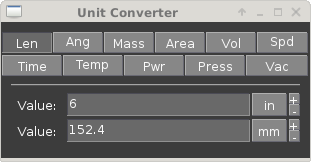SYNOPSIS
#include <agar/core.h> #include <agar/gui.h>
DESCRIPTION
 The Agar
AG_Units interface implements unit conversion.
The
AG_Unit structure is defined as follows:
The Agar
AG_Units interface implements unit conversion.
The
AG_Unit structure is defined as follows:
typedef struct ag_unit {
char *key;
char *abbr;
char *name;
double divider;
double (*func)(double, int mode);
} AG_Unit;
The key member is a unique identifier for this unit. abbr is an abbreviated symbol, and name is the full name of the unit.
The linear conversion factor is specified in divider. For non-linear conversions, func can be defined instead (the first argument to the function is the value to convert; if mode is 1, the function make the reverse conversion).
A set of standard conversion unit groups are defined in gui/units.c in the Agar sources. The standard groups are summarized below.
GENERAL ↑
| agPercentageUnits | Value in percentile |
| agFrequencyUnits | Units of frequency |
| agTimeUnits | Units of time |
LENGTHS & ANGLES ↑
| agLengthUnits | Units of length/distance |
| agAngleUnits | Units of angular measurement |
| agVideoUnits | Units of video pixel resolution |
| agAreaUnits | Units of area |
| agVolumeUnits | Units of volume |
| agSpeedUnits | Units of velocity |
PHYSICAL ↑
| agMassUnits | Units of weight |
| agPressureUnits | Units of pressure and stress (general) |
| agVacuumUnits | Units of pressure (low pressures) |
| agThermalConductivityUnits | Units of thermal conductivity |
| agThermalExpansionUnits | Units of thermal expansion |
| agDensityUnits | Units of density |
| agLightUnits | Units of light intensity |
| agSubstanceAmountUnits | Units of substance amount (moles) |
THERMODYNAMICS ↑
| agPowerUnits | Units of power |
| agTemperatureUnits | Units of temperature |
| agEnergyPerSubstanceAmountUnits | Units of energy per substance amount |
| agMolarHeatCapacityUnits | Units of molar heat capacity |
ELECTRICAL ↑
| agEMFUnits | Units of electromotive force / voltage |
| agCurrentUnits | Units of electrical current |
| agResistanceUnits | Units of electrical resistance |
| agResistanceTC1Units | Units of first-order temperature coefficients |
| agResistanceTC2Units | Units of second-order temperature coefficients |
| agResistivityUnits | Units of resistivity of a material |
| agCapacitanceUnits | Units of electrical capacitance |
| agInductanceUnits | Units of electrical inductance |
INTERFACE ↑
const AG_Unit * AG_FindUnit (const char *key)
const AG_Unit * AG_BestUnit (const AG_Unit *unit_group, double n)
char * AG_UnitFormat (double n, const AG_Unit unit_group[])
const char * AG_UnitAbbr (const AG_Unit *unit)
double AG_Unit2Base (double n, const AG_Unit *unit)
double AG_Base2Unit (double n, const AG_Unit *unit)
double AG_Unit2Unit (double n, const AG_Unit *unit_from, const AG_Unit *unit_to)
The AG_FindUnit() function searches the unit database for a unit matching the given key, and returns a pointer to the unit on success or NULL if none was found.
The AG_BestUnit() function returns the unit expected to yield the least number of non-significant figures when formatting the given number n. AG_UnitFormat() formats the given number n using the best unit in unit_group.
AG_UnitAbbr() returns the abbreviation string associated with the given unit.
The AG_Unit2Base() function converts from n in specified units to the equivalent number of base units. AG_Base2Unit() converts n base units to the equivalent number of specified units.
EXAMPLES ↑
One widget which uses this interface is
AG_Numerical(3), which accepts
unit arguments.
The following code fragment creates a widget for editing
a length value given in meters:
The following code fragment prints the equivalent milliseconds for a given n number of seconds:
The following code fragment prints the equivalent of 27 degrees Celsius, in kilo Kelvins:
This code fragment displays the value of r using the resistance unit most suitable to its magnitude.
Also see tests/unitconv.c in the Agar source distribution.
float length = 1.234; AG_Numerical *num; num = AG_NumericalNewFlt(parent, 0, "m", "Length: ", &length)
The following code fragment prints the equivalent milliseconds for a given n number of seconds:
printf("%f seconds = %f milliseconds", n,
AG_Base2Unit(n, AG_FindUnit("ms")));
The following code fragment prints the equivalent of 27 degrees Celsius, in kilo Kelvins:
const AG_Unit *degC = AG_FindUnit("degC");
const AG_Unit *kk = AG_FindUnit("kk");
printf("27C = %fkk", AG_Unit2Unit(27.0, degC, kk));
This code fragment displays the value of r using the resistance unit most suitable to its magnitude.
printf("Resistance = %s", AG_UnitFormat(r, agResistanceUnits));
Also see tests/unitconv.c in the Agar source distribution.
SEE ALSO ↑
HISTORY ↑
The
AG_Units facility first appeared in
Agar 1.0.

